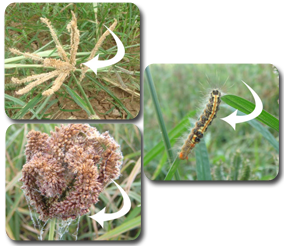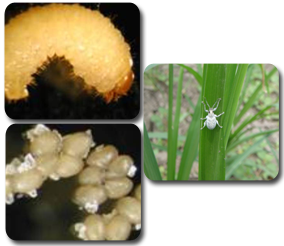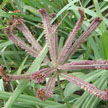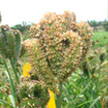Crop Protection
 |
|
|---|---|
Pest |
Disease |
Pest
-
Pink stem borer
-
White stem borer
-
Leaf folder
-
Cut worm
-
Flea beetle
-
Black hairy caterpillar
-
Grasshopper
-
Stink bug
-
Earhead caterpillar
-
Earhead bug
-
Root aphid
-
Ragi jassid
-
Root grub
-
Yellow aphid
-
Brown aphid
-
Weevil
 Top of page
Top of page
Pink Stem Borer, Sesamia inferens
i.Symptoms of damage
|
 |
 Top of page
Top of page
ii.Identification of the pest
Egg: Creamy white spherical shape eggs laid in clusters in the leaves and stem of the plant. Incubation period is 8 days Larva: Pinkish brown, smooth and cylindrical with reddish brown head. Laval period is 22 days Pupa: Dark brown with purple tinge in head. Pupate inside the stem. Pupation period is 8 days Adult: medium sized, pale yellow brown moths. Fore wings are light brown with two black spots. Hind wings are white with light yellow scales along the major veins |
 |
 Top of page
Top of page
iii.Control Measures
Cultural:
Biological: Apply bio control agents- Telenomus sp., Trichogramma minutum (egg parasites) and Apanteles flavipes, Bracon drinensis (larval parasites) and Tetrastichus ayyari (pupal parasites) |
|
Chemical:
|
|
 Top of page
Top of page
White Stem Borer, Saluria inficita
i.Symptoms of damage
|
 |
 Top of page
Top of page
ii.Identification of the pest
Egg: The eggs are laid in batches of about 100 and are covered with silky greyish hairs; they resemble the eggs of the yellow stem borer. The incubation period is about 8 days. The female white stem borer lays the eggs near the tip of the leaf blade. Larva: Creamy white with yellow head Pupa: Brown, obtect type, pupates inside the stem Adult: Ddark brown, with white band along the margin of each forewing |
 |
 Top of page
Top of page
iii.Control Measures
|
 Top of page
Top of page
Leaf Folder, Cnaphalocrocis Medinalis
i.Symptoms of damage
|
 |
 Top of page
Top of page
ii.Identification of the pest
Egg: Each female lay 300 eggs on both sides of leaves. It is oblong and whitish yellow in colour. Egg period is 4 to 6 days |
 |
 Top of page
Top of page
iii.Correction Measures
Cultural:
|
|
Biological:
Chemical:
Mechanical:
|
|
 Top of page
Top of page
Cut Worm, Spodoptera exigua
i.Symptoms of damage
|
 |
 Top of page
Top of page
ii.Identification of the pest
Eggs: Lays clusters of pearly white and round eggs on the lower portion of young plants Larva: Stout, soft bodied, brownish green larvae with wavy lines on dorsal surface and yellow stripe laterally. Larva period is 10-16 days Pupa: pupate in the soil in earthern cocoons. Pupal period is 7-11 days Adult: brownish moth with white hind wings |
 |
 Top of page
Top of page
iii.Correction Measures
Cultural:
|
|
Biological:
Mechanical: Place aluminum foil or cardboard collars around transplant stem at planting time. This creates a barrier that physically prevents cutworm larvae from feeding on plants. |
|
 Top of page
Top of page
Flea Beetle, Chaetocnema pusaensis
i.Symptoms of damage
|
 |
 Top of page
Top of page
ii.Identification of the pest
|
 |
 Top of page
Top of page
iii.Control Measures
|
 |
 Top of page
Top of page
Black Hairy Caterpillar, Estigmene lactinea
i.Symptoms of damage
|
 |
 Top of page
Top of page
ii.Identification of the pest
Egg: Eggs are laid on the plants Larva: Thick with black head and hairs all over the body Pupa: Pupates in soil Adult: Large white moth with crimson markings on head, body and wings |
 |
 Top of page
Top of page
iii.Control Measures
|
 Top of page
Top of page
Grasshopper, Chrotogonus trachypterus
i.Symptoms of damage
|
 |
 Top of page
Top of page
ii.Identification of the pest
Egg: Grasshopper lays cluster of eggs in soil. Eggs laid in oval, elongate or curved pods made out of soil particles. Eggs may be white, yellow green, tan, or various shades of brown. Nymph: Newly hatched nymphs are white. After several hours of exposure to sunlight, they assume the distinctive colors and markings of adults. Nymphal period is 35 to 50 days Adult: stout, greenish brown colour with yellow stripe on the sides |
 |
 Top of page
Top of page
iii.Control Measures
Cultural:
|
|
Biological:
|
|
 Top of page
Top of page
Stink Bug, Nezara Viridula
i.Symptoms of damage
|
 |
 Top of page
Top of page
ii.Identification of the pest
Eggs
Nymphs
Adults
|
 |
 Top of page
Top of page
iii.Control Measures
|
 Top of page
Top of page
Ear head caterpillar, Euproctis subnotata
i.Symptoms of damage
|
 |
 Top of page
Top of page
ii.Identification of the pest
Egg: Spherical transparent white eggs are laid in masses (6 to 24 eggs in each) and covered by orange-yellow hairs Larva: The hairy caterpillar is smaller, dark brown with a wide yellow band and less hairy. An orange-red line runs along the yellow band. Larval period is 15 to 40 days Pupa: It pupates in the soil. Pupal period is one month. Adult: The adult moths have brown forewings with dark scales. The hind wings are yellow |
 |
 Top of page
Top of page
iii.Control Measures
Cultural method
Chemical method
Mechanical method
|
 Top of page
Top of page
Ear Head Bug, Calocoris Angustatus
i.Symptoms of damage
|
 |
 Top of page
Top of page
ii.Identification of the pest
Egg - Blue cigar shaped, laid under the glumes or into the middle of the florets Nymphs - Slender, green in colour Adults - Male is green in colour. Female is green with a brown margin |
 |
 Top of page
Top of page
iii.Control Measures
Cultural method:
Chemical method: Application of Carbaryl 50 SP @ 3 Kg in 500 litre of water/ha on panicles |
 Top of page
Top of page
Root Aphid, Tetraneura nigriabdominalis
i.Symptoms of damage
|
 |
 Top of page
Top of page
ii.Identification of the pest
|
 |
 Top of page
Top of page
iii.Control Measures
|
 Top of page
Top of page
Ragi Jassid, Cicadulina Bipunctella
i.Symptoms of damage
|
 |
 Top of page
Top of page
ii.Identification of the pest
Nymph:Pale greenish almost tranuslucent and walk diagonally. Nymphal period is 7 to 9 days Adult: small, brown colored, wedge shaped. Adults live for 2 to 3 weeks |
 |
 Top of page
Top of page
iii.Control Measures
|
 Top of page
Top of page
Root Grub, Holotrichia consanguinea
i.Symptoms of damage
|
 |
 Top of page
Top of page
ii.Identification of the pest
|
 |
 Top of page
Top of page
iii.Control Measures
Cultural control:
Mechanical Control:
Biological Control: Conserve braconids,dragon flies, trichogrammatids, NPV, green muscardine fungus |
 Top of page
Top of page
Yellow Aphid, Schizaphis graminum
i.Symptoms of damage
|
 |
 Top of page
Top of page
ii.Identification of the pest
Adult: greenish yellow aphids |
 |
 Top of page
Top of page
iii.Control Measures
|
 Top of page
Top of page
Brown Aphid, Hysteroneura setariae
i.Symptoms of damage
|
 |
 Top of page
Top of page
ii.Identification of the pest
Adult: Brown coloured aphids |
 |
 Top of page
Top of page
iii.Control Measures
|
 Top of page
Top of page
Weevil, Myllocerus discolor
i.Symptoms of damage
|
 |
 Top of page
Top of page
ii.Identification of the pest
Eggs: Small, ovid and cream colored Grub: C shaped, creamy white with brown heads and legeless Pupa: Creamy white and resemble adults, and are found in earthern cells in the soil Adult: Whitish grey with an irregular pattern of dark spots dorsally. The snout is short and quadrate and slightly expanded towards the apex. The antennae are clubbed and elbowed |
 |
 Top of page
Top of page
iii.Control Measures
|
 Top of page
Top of page
Disease
-
Blast
-
Seedling blight
-
Foot rot or Wilt
-
Smut
-
Downy mildew
-
Mosaic virus
-
Mottle streak
-
Bacterial leaf spot
 Top of page
Top of page
Blast, Piricularia Grisea
i.Symptoms of damage
|
 |
 Top of page
Top of page
ii.Identification of pathogen
|
 |
 Top of page
Top of page
iii.Control Measures
|
|
|
|
 Top of page
Top of page
Seedling blight, Helminthosporium nodulosum
i.Symptoms of damage
|
 |
 Top of page
Top of page
ii.Identification of pathogen
|
 |
 Top of page
Top of page
iii.Control Measures
Cultural:
Chemical:
|
 Top of page
Top of page
Foot Rot or Wilt, Sclerotium Rolfsii
i.Symptoms of damage
|
 |
 Top of page
Top of page
ii.Identification of pathogen
|
 |
 Top of page
Top of page
iii.Control Measures
|
 Top of page
Top of page
Smut, Melanopsichium eleusinis
i.Symptoms of damage
|
 |
 Top of page
Top of page
ii.Identification of pathogen
|
 |
 Top of page
Top of page
iii.Control Measures
|
 Top of page
Top of page
Downy Mildew, Sclerophthora Macrospora
i.Symptoms of damage
|
 |
 Top of page
Top of page
ii.Identification of pathogen
|
 |
|
|
 Top of page
Top of page
iii.Control Measures
|
 Top of page
Top of page
Mosaic, Virus
i.Symptoms of damage
|
 |
 Top of page
Top of page
ii.Identification of pathogen
|
 |
 Top of page
Top of page
iii.Control Measures
|
 Top of page
Top of page
Mottle Streak, Nucleorhabdovirus
i.Symptoms of damage
|
 |
 Top of page
Top of page
ii.Identification of pathogen
Nucleorhabdovirus or Potato Yellow Dwarf Virus is bacilliform, with one type of particle of about 380 x 75 nm. It is enveloped with a clear modal length of 178-224nm, 59-76 nm wide. Axial canal obvious; 8 nm in diameter |
 |
 Top of page
Top of page
iii.Control Measures
|
 Top of page
Top of page
Bacterial Leaf Spot, Xanthomonas campestris pv. eleusineae
i.Symptoms of damage
|
 |
 Top of page
Top of page
ii.Identification of pathogen
The bacterium is a rod with a single polar flagellum. |
 |
 Top of page
Top of page
iii.Control Measures
|




